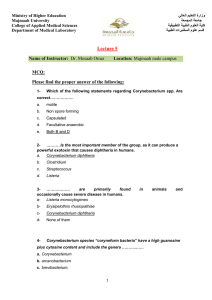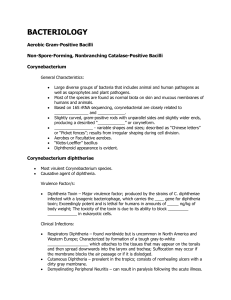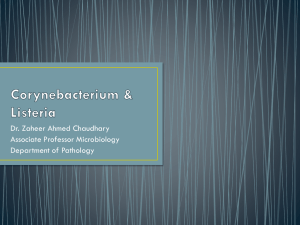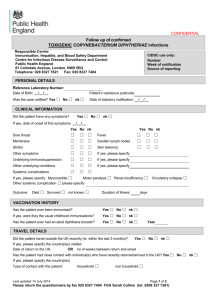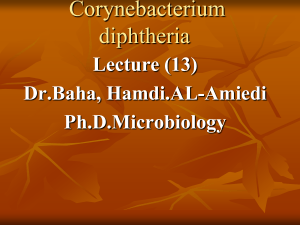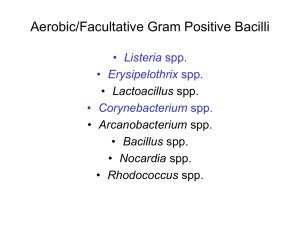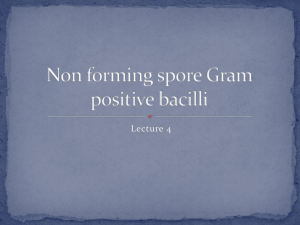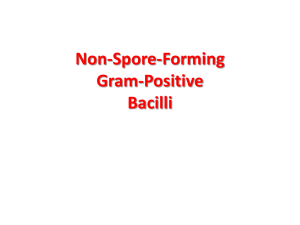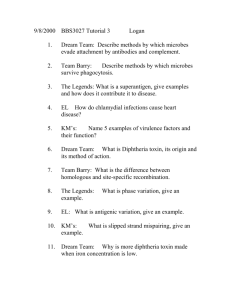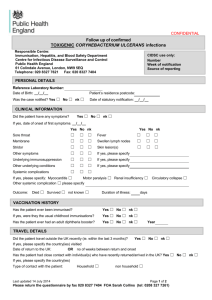Corynebacterium - Cal State LA
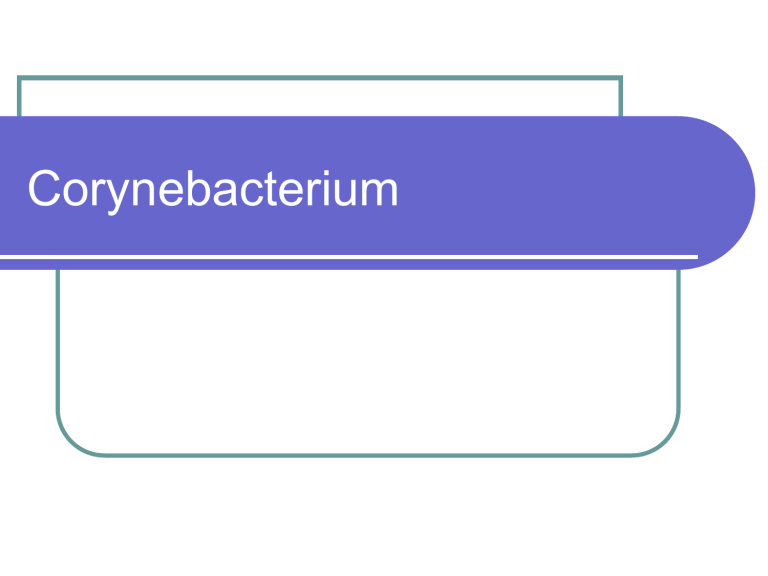
Corynebacterium
Corynebacterium
Classification
Corynebacterium diphtheriae and diphtheroids
(look like C. diphtheriae ) are Gram- positive, club shaped rods.
Some are saprophytic
Some produce disease in animals.
C. diphtheriae is the most important pathogen in the group.
Morphology and cultural characteristics
Small G+B; arrangement=palisade or Chinese
letters
Growth on B.A – raised, translucent, gray colonies
Diphtheroids Gram stain
Arrangement of
C. diphtheria
Corynebacterium
Loeffler‘s agar slant contains serum and egg that enhance the formation of metachromatic granules (polymerized polyphosphoric acid) in C. diphtheriae .
Also called Babes-Ernst granules.
They are visualized by staining with methylene blue.
Methylene blue stain from
Loefflers slant
Corynebacterium
A medium containing tellurite should be used to select for Corynebacterium and other
G+ organisms -it inhibits G organisms. Two kinds are used:
Cystine tellurite has a longer shelf life
Tinsdale helps to differentiate amongst the
Corynebacterium .
Colonies on either appear black or gray due to tellurite reduction.
S. aureus and Listeria also grow as black colonies.
On Tinsdale C. diphtheriae, ulcerans, and pseudotuberculosis form brown halos around the colonies due to formation of ferric sulfide.
Corynebacterium
3 morphological types of C. diphtheriae are found on tellurite containing media:
Mitis – black colonies with a gray periphery
Gravis – large, gray colonies
Intermedius – small, dull gray to black.
All produce an immunologically identical toxin.
Incubation -35-37 0 C for 24 hours.
They prefer a pH of 7.8-8.0 for good growth.
They require access to oxygen (poor AnO
2 growth).
Biochemistry
Catalase +
Corynebacterium
Nonmotile
C. ulcerans is urease +, C. diphtheriae is -, and C. pseudotuberculosis is usually +
Virulence factors C. diphtheriae
For C. diphtherias to cause diphtheria an exotoxin must be produced.
Is a heat-labile polypeptide produced during lysogeny of a
phage that carries the "tox” gene.
Alkaline pH of 7.8- 8.0, aerobic conditions, and a low environmental iron level are essential for toxin production
(occurs late in the growth of the organism).
The toxin inhibits protein synthesis by ADP-ribosylating elongation factor 2.
What other organism produces a similar toxin?
Corynebacterium
Trypsin cleaves the toxin into 2 fragments, A and B, that are linked together by a disulfide bridge.
Fragment B is required for toxin binding to tissue cells and fragment A contains the toxic activity.
One molecule of toxin can inhibit 90% of the protein synthesis in a cell.
Systemic effects include heart failure, paralysis and adrenal hypofunction leading to an Addison’s like disease.
C. ulcerans and C. pseudotuberculosis sometimes make a diphtheria-like toxin.
C. diphtheria
toxin
Toxin enters through receptor mediated endocytosis
Acidification of endocytic vesicle allows A to dissociate from B
A enters cycoplasm
C. diphtheria
toxin
Corynebacterium
To prove that an isolate can cause diphtheria, one must demonstrate toxin production.
This is most often done on an Elek plate:
The organism is streaked on a plate containing low iron.
A filter strip containing anti-toxin antibody is placed perpendicular to the streak of the organism.
Diffusion of the antibody into the medium and secretion of the toxin into the medium occur.
At the zone of equivalence, a precipitate will form.
Elek plate
Corynebacterium
Guinea pig or tissue culture toxicity assays may also be done.
Capsule – is protein in nature
Cord factor – is a complex glycolipid
(trehalose 6,6’-dicorynemycolate) that has been shown to disrupt mouse mitochondria.
It has not been shown to play a role in the production of diphtheria.
Corynebacterium
Clinical Significance ( C. diphtheria )
Is normally found in the throats of healthy carriers.
The organism infects only man and it has a limited capacity to invade.
Diphtheria - Disease usually starts as a local infection of the mucous membranes causing a membranous pharyngitis
Local toxin effects result in degeneration of epithelial cells.
Inflammation, edema, and production of a pseudomembrane composed of fibrin clots, leukocytes, and dead epithelial cells and microorganisms occurs in the throat.
Diphtheria - pseudomembrane
This may obstruct the airway and result in suffocation.
Corynebacterium
The more dangerous effects occur when the toxin becomes systemic and attacks the heart
(heart failure), peripheral nerves (paralysis), and the adrenal glands (hypofunction).
Cutaneous diphtheria More common in tropical and subtropical areas.
Necrotic lesions with occasional formation of a local pseudomembrane occur.
Antibiotic susceptibility and treatment
Antiserum once the toxin has bound, however, the antiserum against it is ineffective.
Penicillin to eliminate the organism.
Corynebacterium
Prevention- Active immunization with toxoid (alum precipitate).
Is part of the DPT vaccine.
Shick skin test like the Dick test in that it tests for circulating antibody to the toxin by injecting a small amount of toxin intradermally and observing for a local erythematous and necrotic reaction.
If this occurs it indicates that the person has no antitoxin antibodies and is, therefore, susceptible to diphtheria.
Other Corynebacterium are part of the normal flora of the skin and URT.
Corynebacterium
Are called diphtheroids and may occasionally cause disease, particularly in immunocompromised individuals.
C. ulcerans toxigenic strains may produce a disease similar to, but less severe than diphtheria.
J-K Group commonly cause infections in those with underlying disease.
Diseases include bacteremia, meningitis, peritonitis, wound infections, etc.
It is becoming more and more of a problem.
C. pseudotuberculosis found in those with exposure to animals.
Can cause pneumonia or lymphadenitis.
Produces a different exotoxin than C. diphtheriae .
